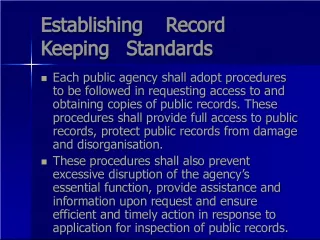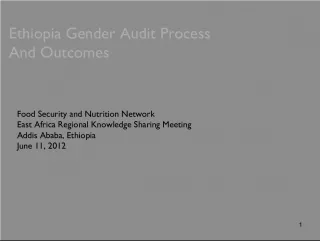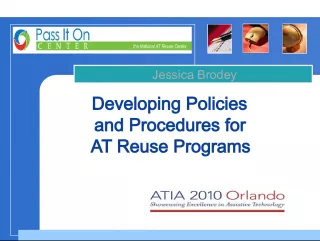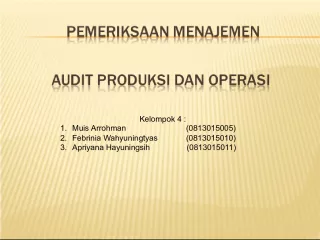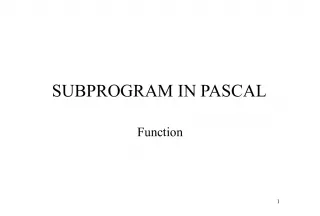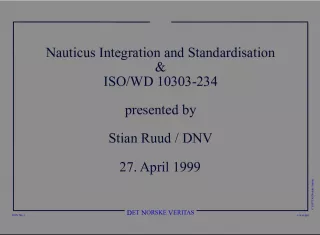Audit Standards and Sampling Procedures
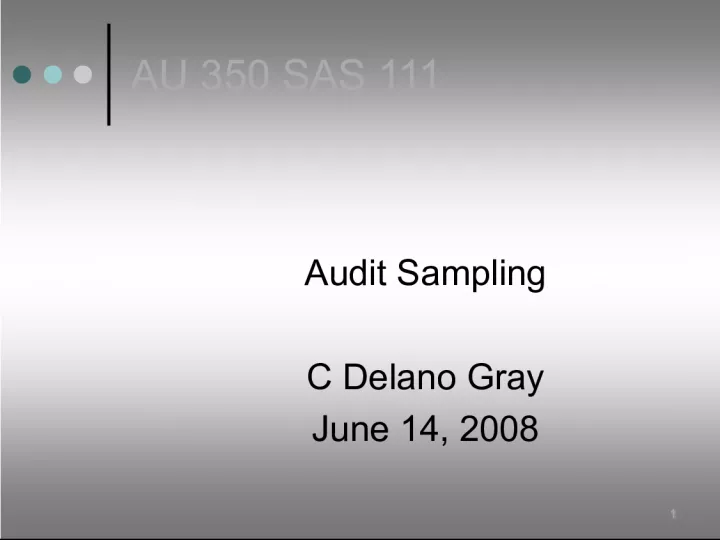

This document outlines the auditing standards and procedures to be followed during the audit of SAS 111 for company 11 AU 350. The audit will be conducted by a person or persons with adequate technical training
- Uploaded on | 2 Views
-
 veeti
veeti
About Audit Standards and Sampling Procedures
PowerPoint presentation about 'Audit Standards and Sampling Procedures'. This presentation describes the topic on This document outlines the auditing standards and procedures to be followed during the audit of SAS 111 for company 11 AU 350. The audit will be conducted by a person or persons with adequate technical training. The key topics included in this slideshow are . Download this presentation absolutely free.
Presentation Transcript
Slide111 AU 350 SAS 111 Audit Sampling C Delano Gray June 14, 2008
Slide222 Generally accepted auditing standards
Slide333 1. The audit is to be performed by a person or persons having adequate technical training and proficiency as an auditor. 2. The auditor must maintain independence in mental attitude in all matters relating to the audit. General Standards
Slide444 General Standards 3. The auditor must exercise due professional care in the performance of the audit and the preparation of the report.
Slide555 1. The auditor must adequately plan the work and must properly supervise any assistants. 2. The auditor must obtain a sufficient Understanding of the entity and its environment, including its internal control, to assess the risk of material misstatement and to design further audit procedures. Standards of Field Work
Slide666 Standards of Field Work 3. The auditor must obtain sufficient appropriate audit evidence by performing audit procedures to afford a reasonable basis for an opinion regarding the financial statements under audit.
Slide777 1. The report shall state whether the financial statements are presented in accordance with generally accepted accounting principles. 2. The report shall identify those circumstances in which such principles have not been consistently observed in the current period in relation to the preceding period. Standards of Reporting
Slide888 3. Informative disclosures in the financial statements are to be regarded as reasonably adequate unless otherwise stated in the report. 4. The report shall contain an expression of opinion regarding the financial statements, taken as a whole. Standards of Reporting
Slide999 Generally Accepted Auditing Standards General Standards 1. Adequate training and proficiency 2. Independence in mental attitude 3. Due professional care
Slide101010 Generally Accepted Auditing Standards Standards of Field Work 1. Proper planning and supervision 2. Understanding of the entity 3. Sufficient appropriate evidence
Slide111111 Generally Accepted Auditing Standards Standards of Reporting 1. Statements prepared in accordance with GAAP 2. Circumstances when GAAP not followed 3. Adequacy of disclosures 4. Expression of opinion on financial statements
Slide12 12Audit Sampling for Tests of Controls Substantive Tests of Transactions
Slide131313 AICPA SAS 111 . 01 Audit sampling is the application of an audit procedure to less than 100 percent of the items within an account balance or class of transactions for the purpose of evaluating some characteristic of the balance or class. This section provides guidance for planning, performing, and evaluating audit samples. Source AICPA
Slide141414 . 02 The auditor often is aware of account balances and transactions that may be more likely to contain misstatements. He considers this knowledge in planning his procedures, including audit sampling.
Slide151515 . 03 There are two general approaches to audit sampling: non-statistical and statistical. Both approaches require that the auditor use professional Judgment in planning, performing, and evaluating a sample and in relating the audit evidence produced by the sample to other audit evidence when forming a conclusion about the related account balance or class of transactions. The guidance in this section applies equally to non-statistical and statistical sampling.
Slide161616 .04 The third standard of field work states, "The auditor must obtain sufficient appropriate audit evidence by performing audit procedures to afford a reasonable basis for an opinion regarding the financial statements under audit." Either approach to audit sampling, when properly applied, can provide sufficient audit evidence.
Slide171717 Representative sampling.
Slide181818 Representative Samples A representative sample is one in which the characteristics in the sample of audit interest are approximately the same as those of the population. Nonsampling risk is the risk that audit tests do not uncover existing exceptions in the sample.
Slide191919 Representative Samples Sampling risk is the risk that an auditor reaches an incorrect conclusion because the sample is not representative of the population. Sampling risk is an inherent part of sampling that results from testing less than the entire population.
Slide202020 Distinguish between statistical and nonstatistical sampling and between probabilistic and non- probabilistic sample selection.
Slide212121 Statistical Versus Nonstatistical Sampling Step 1: Plan the sample Step 2: Select the sample and perform the tests Step 3: Evaluate the results Similarities:
Slide222222 Statistical Versus Nonstatistical Sampling Statistical sampling allows the quantification of sampling risk in planning the sample (Step 1) and evaluating the results (Step 3) In nonstatistical sampling those items that the auditor believes will provide the most useful information are selected Differences:
Slide232323 Probabilistic Versus Nonprobabilistic Sample Selection Probabilistic sample selection is a method of selecting a sample such that each population item has a known probability of being included in the sample. Nonprobabilistic sample selection is a method in which the auditor uses professional judgment rather than probabilistic methods.
Slide242424 Probabilistic Versus Nonprobabilistic Sample Selection 1. Directed sample selection 2. Block sample selection 3. Haphazard sample selection Nonprobabilistic:
Slide252525 Probabilistic Versus Nonprobabilistic Sample Selection 1. Simple random sample selection 2. Systematic sample selection 3. Probability proportional to size sample selection 4. Stratified sample selection Probabilistic:
Slide262626 Nonprobabilistic Sample Selection Methods Directed sample selection is the selection of each item based on auditor judgmental criteria. Items most likely to contain misstatements Items containing selected population characteristics Large dollar coverage
Slide272727 Nonprobabilistic Sample Selection Methods Block sample selection is the selection of several items in sequence. Haphazard sample selection is the selection of items without any conscious bias on the part of the auditor.
Slide282828 Select representative samples.
Slide292929 Probabilistic Sample Selection Methods A simple random sample is one in which every possible combination of elements in the population has an equal chance of constituting the sample. Computer generation of random numbers Random number tables
Slide303030 Probabilistic Sample Selection Methods Systematic sample selection: The auditor calculates an interval and then selects the items for the sample based on the size of the interval. The interval is determined by dividing the population size by the number of sample items desired.
Slide313131 Probabilistic Sample Selection Methods Probability proportional to size: A sample is taken where the probability of selecting any individual population item is proportional to its recorded amount (PPS).
Slide323232 Probabilistic Sample Selection Methods Stratified sample selection: The population is divided into subpopulations by size and larger samples are taken of the larger subpopulations.
Slide333333 Sampling for Exception Rates The occurrence rate , or exception rate , is the ratio of the items containing the specific attribute to the total number of population items.
Slide343434 Sampling for Exception Rates Following are types of exceptions in populations of accounting data: 1. Deviations from client’s established controls 2. Monetary misstatements in populations of transaction data 3. Monetary misstatements in populations of account balance details
Slide353535 I: Plan the Sample Step 1: State the objectives of the audit test. Step 2: Decide whether audit sampling applies. Step 3: Define attributes and exception conditions. Step 4: Define the population. Step 5: Define the sampling unit.
Slide363636 I: Plan the Sample Step 7: Specify acceptable risk of assessing control risk too low. Step 8: Estimate the population exception rate. Step 9: Determine the initial sample size. Step 6: Specify the tolerable exception rate.
Slide373737 II: Select the Sample and Perform the Audit Procedures Step 10: Select the sample. Step 11: Perform the audit procedures.
Slide383838 III: Evaluate the Results Step 12: Generalize from the sample to the population. Step 13: Analyze exceptions. Step 14: Decide the acceptability of the population.
Slide393939 Effect on Sample Size of Changing Factors Effect on initial Type of change sample size Increase acceptable risk of assessing control risk too low Decrease Increase tolerable risk rate Decrease Increase estimated population exception rate Increase Increase population size Increase (minor)
Slide404040 When planning a particular audit sample for a test of controls, the auditor should consider: • The relationship of the sample to the objective of the test of controls. • The maximum rate of deviations from prescribed controls that would support his planned assessed level of control risk. • The auditor's allowable risk of assessing control risk too low. • Characteristics of the population, that is, the items comprising the account balance or class of transactions of interest.
Slide414141 Probability Proportion to Size Probability proportional to size (PPS) is a sampling technique for use with surveys or mini-surveys in which the probability of selecting a sampling unit is proportional to the size of its population. It gives a probability (i.e., random, representative) sample.
Slide424242 It is most useful when the sampling units vary considerably in size because it assures that those in larger dollar value Transaction have the same probability of getting into the sample as the smaller ones, and vice verse.
Slide434343 Define and describe attributes sampling and a sampling distribution.
Slide444444 Statistical Audit Sampling The statistical sampling method most commonly used for tests of controls and substantive tests of transactions is attributes sampling .
Slide454545 Sampling Distribution It is a frequency distribution of the results of all possible samples of a specified size that could be obtained from a population containing some specific parameters. Attributes sampling is based on the binomial distribution.
Slide464646 Use of attributes sampling in tests of controls and substantive tests of transactions.
Slide474747 Application of Attributes Sampling Population size is a minor consideration in determining sample size Representativeness is ensured by the sample selection process more than by sample size Effect of population size:
Slide484848 Application of Attributes Sampling Select the sample Perform the audit procedures Evaluate the results
Slide49 49End Questions?????




